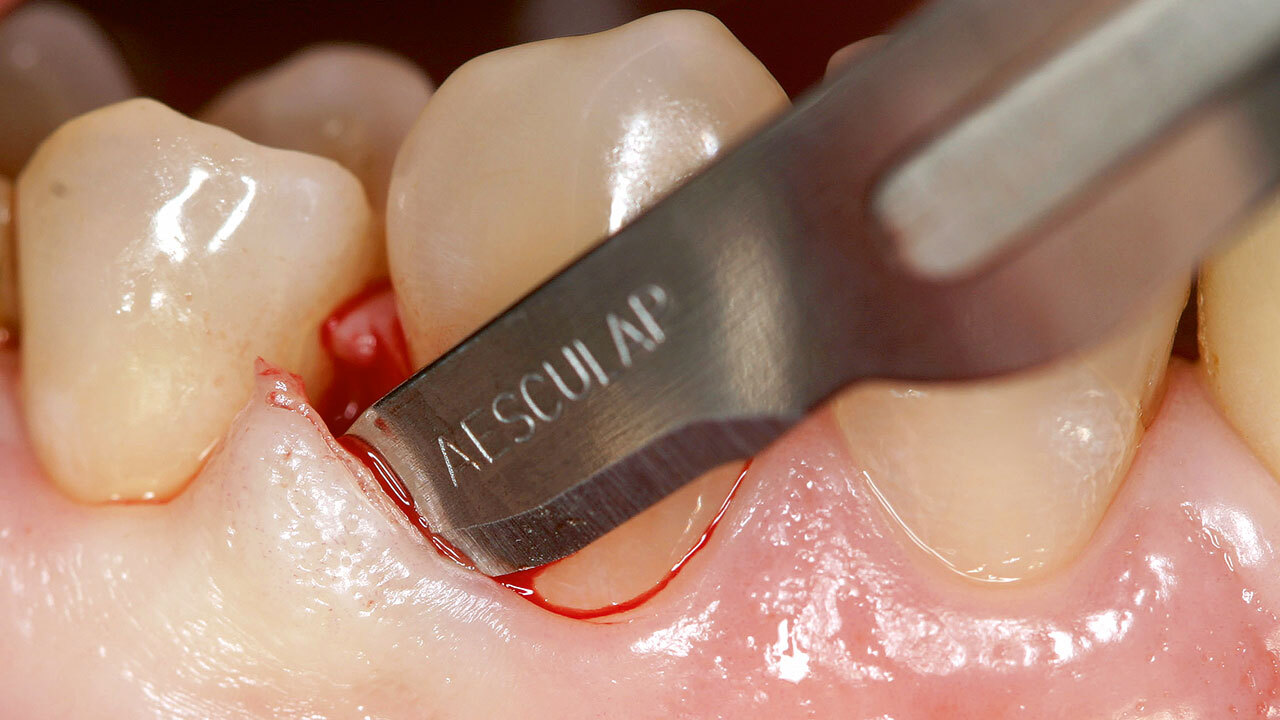Parodontologie, 1/2023
KongressberichtPages 109-112, Language: GermanStein, Jamal M.Quintessenz Zahnmedizin, 10/2019
ParodontologiePages 1148-1159, Language: GermanStein, Jamal M.Die meisten Parodontitisfälle können mittels alleiniger antiinfektiöser Therapie erfolgreich behandelt werden. Hingegen spielen bei fortgeschrittenen Parodontalerkrankungen korrektive chirurgische Maßnahmen eine bedeutende Rolle. Dabei sollte die Wahl des geeigneten Verfahrens stets unter Berücksichtigung der Einzelzahnprognosen und der prothetisch-implantologischen Planung erfolgen. Grundsätzlich können reparative, regenerative und resektive parodontalchirurgische Techniken unterschieden werden. Während resektive Maßnahmen bei supraalveolären und flachen infraalveolären Defekten im ästhetisch nicht kritischen Bereich indiziert sind, erlauben tiefe infraalveoläre Defekte einen regenerativen Ansatz unter Nutzung von unterschiedlichen papillenerhaltenden und minimalinvasiven Lappendesigns. Klassische reparative Verfahren zur Taschenreduktion spielen aus heutiger Sicht eine untergeordnete Rolle. Eine Restindikation liegt allerdings für supraalveoläre Taschen im Seitenzahnbereich mit einem Mindestanteil an keratinisierter Gingiva vor. Bei interradikulären Defekten bestimmen der Grad und die Lage der Furkation die therapeutische Tendenz. In dem Beitrag werden die wichtigsten Kriterien für die Wahl des Lappendesigns erläutert und Entscheidungshilfen für die Praxis angeboten.
Keywords: Korrektive chirurgische Therapie, regenerative Parodontaltherapie, Papillenerhaltungslappen, apikaler Verschiebelappen, Lappendesign
International Journal of Periodontics & Restorative Dentistry, 6/2015
DOI: 10.11607/prd.2203, PubMed ID (PMID): 26509992Pages 876-884, Language: EnglishStein, Jamal M. / Hammächer, ChristianRidge preservation in the esthetic area is still a challenging procedure. The aim of the present case series was to introduce a technique for postextraction socket seal surgery using an epithelized connective tissue graft and socket filling with a xenogeneic biomaterial. Using a tunneling approach, the buccal gingiva and interdental papillae are undermined and augmented with the soft tissue graft. This method was applied and evaluated in 16 sites in 13 patients with need for extraction of at least one maxillary anterior tooth. Five months postoperative, the mean reduction of the horizontal width of the alveolar ridge was 0.5 mm, while the height of the mesial and distal papillae were reduced by 0.2 mm and 0.4 mm, respectively. The buccogingival margin of the alveolar ridge showed a vertical gain of 0.5 mm. Therefore, the presented technique seems appropriate for preservation of the alveolar ridge in esthetically relevant areas.
International Poster Journal of Dentistry and Oral Medicine, 2/2015
Poster 869, Language: German, EnglishSchulz, Susanne / Reichert, Stefan / Streetz, Konrad / Trautwein, Christian / Gläser, Christiane / Schaller, Hans-Günter / Stein, Jamal M.Background: Crohn's disease (CD) is a chronic inflammatory bowel disease often accompanied by periodontal symptoms. Based on its function in immune response tumour necrosis factor-alpha (TNF-a) and its genetic variants have been discussed as risk indicators in inflammatory processes. Therefore, the aim of the present study was to investigate the impact of TNF-a polymorphisms on periodontal parameters and inflammatory lesions of oral mucosa as a characteristic of CD.
Patients and methods: A total of 142 patients with CD were included in the study. Oral soft tissue alterations and periodontal parameters were assessed. Genotypes, alleles, and haplotypes of TNF-a polymorphisms (rs1800629: c.-308G>A and rs361525: c.-238G>A) were determined by polymerase chain reaction with sequence-specific primers (PCR-SSP).
Results: CD patients who exhibited more severe oral soft tissue alterations were significantly more often A allele carriers of rs361525 than G allele carriers (14.2% vs. 2.2%; p0.001). Furthermore, A allele carriers had a higher mean periodontal probing depth (p0.05), mean clinical attachment level (p0.05) and sites with bleeding on probing (n.s.). Similar results were obtained evaluating A allele containing genotypes (AG+AA) and haplotype (GA). In multivariate analyses considering age, gender, smoking, and medication as cofounders, the A allele was proven to be an independent risk indicator for oral soft tissue alterations in CD patients. No genotype dependent influence of rs1800629 was observed. Conclusions: TNF-a A allele of rs361525 represents a significant risk indicator for oral soft tissue alterations in CD patients.
Keywords: TNF-a, genetic, Morbus Crohn, periodontitis
International Poster Journal of Dentistry and Oral Medicine, 3/2014
Poster 808, Language: EnglishSchulz, Susanne / Reichert, Stefan / Streetz, Konrad / Trautwein, Christian / Reichert, Yvonne / Gläser, Christiane / Schaller, Hans-Günter / Stein, Jamal M.Background: Based on its function in immune response tumor necrosis factor-alpha (TNFa) has been regarded as a candidate gene for inflammatory diseases, including periodontal disease and Crohn's disease (CD). However, the results regarding the impact of genetic characteristics of TNFa on both diseases are inconsistent. The present study was performed in order to evaluate the influence of TNFa polymorphisms as potential risk factors for Crohn's disease after stratification according to periodontal status. Patients and methods: A total of 142 patients with Crohn's disease were included in the study. Genotypes, alleles and haplotypes of TNFa SNPs (rs1800629: c.-308G>A and rs361525: c.-238G>A) were determined by polymerase chain reaction with sequence-specific primers (PCR-SSP). Statistical analyses were performed applying SPSS 19.0. Results: Patients with Crohn's disease suffering from generalized periodontitis were significantly more often carriers of AA-genotype and A-allele of rs1800629 than Crohn's patients without generalized periodontitis (genotype: pexact=0.044, allele: pcorr.=0.048). In binary logistic regression analyses considering age, gender, smoking, approximal plaque index as potential confounders significant allele- but no genotype-dependent associations were proven (OR=2.22). Evaluating the TNFa polymorphism rs361525 no disease related differences in genotype or allele arrangement could be detected. Conclusions: TNFa polymorphism rs1800629 but not rs361525 was proven to be a significant risk indicator for generalized periodontitis in patients with Crohn's disease.
Keywords: SNPs, TNFa, Crohn's disease, periodontitis
Implantologie, 4/2013
Pages 395-404, Language: GermanHammächer, Christian / Weber, Volker / Edelhoff, Daniel / Stein, Jamal M.Eine Methode zur digitalen Übertragung des Emergenzprofils bei Einzelzahnimplantatversorgungen in der ästhetischen ZoneBei der Implantattherapie im Oberkieferfrontzahngebiet stellt die Erzielung eines vorhersagbaren ästhetischen Ergebnisses die größte Herausforderung dar. Die hierzu möglichen Behandlungsansätze sind vielfältig und es bedarf einer genauen prächirurgischen Diagnostik, um den individuell optimalen Therapieweg festzulegen. Neben den entscheidenden Parametern zur Umsetzung eines ästhetisch zufriedenstellenden Ergebnisses, wie einer adäquaten Implantatposition und einem stabilen periimplantären Hart- und Weichgewebe, bestehen zudem prothetische Optionen, die das Therapieergebnis in einem gewissen Umfang optimieren können. Hierzu gehören unter anderem die Ausformung eines angemessenen Emergenzprofils durch Provisorien sowie dessen Übertragung auf das Arbeitsmodell mittels individueller Abdruckpfosten. Die digitale prothetische Vorgehensweise über konventionelle Abformungen und laborseitigen Scanprozess hat sich in den vergangenen Jahren in der Zahntechnik fest etabliert und die Herstellung von individuellen CAD/CAM-gefertigten Implantatabutments ermöglicht. Diese können mit großem Vorteil in der ästhetischen Zone eingesetzt werden. Die intraorale optische Erfassung von Implantaten mittels eingebrachter Scankörper steht jedoch erst in den Anfängen und ist noch nicht weit verbreitet. Die direkte Digitalisierung bietet zum jetzigen Zeitpunkt noch nicht die Möglichkeit, den ausgeformten Weichgewebetrichter ausreichend zu berücksichtigen. Die im Folgenden beschriebene Technik des Zweifachscans - Erfassung der intraoralen Situation und extraoraler Scan des Provisoriums - mit anschließendem "Datenmatching" soll die bisherige Lücke in der digitalen Prozesskette schließen.
Keywords: Ästhetische Zone, Einzelzahnimplantat, periimplantäres Hart- und Weichgewebe, Implantatposition, Weichgewebeausformung, Emergenzprofil, digitale Erfassung, Scanbody, Datenmatching, individuelle CAD/CAM-Abutments
Quintessenz Zahnmedizin, 9/2012
ParodontologiePages 1127-1137, Language: GermanStein, Jamal M.Die rechtzeitige Erkennung und konsequente Behandlung von parodontalen Erkrankungen stellt einen wichtigen Pfeiler der modernen Zahnheilkunde dar. In Deutschland steht allerdings die Häufigkeit der behandelten Parodontopathien nach wie vor in einem beachtlichen Missverhältnis zu deren Prävalenz. Allein aus forensischer Sicht sollte die Beurteilung des parodontalen Zustands integraler Bestandteil jeder zahnärztlichen Untersuchung sein. Aber auch aufgrund ihrer Schnittstellen zu allen anderen zahnmedizinischen Disziplinen ist die parodontale Diagnostik von entscheidender Bedeutung für die Prognosestellung und die Gesamtbehandlungsplanung. Aus praktischer Sicht ergibt sich die Frage, welche parodontalen Befunde wann erhoben werden sollten und welchen Nutzen sie haben. In dem Beitrag werden die wichtigsten diagnostischen Hilfsmittel für die Praxis zusammenfassend dargestellt und hinsichtlich ihrer Bedeutung beurteilt.
Keywords: Sondierungstiefe, Attachmentniveau, Mikrobiologie, IL-1-Polymorphismus, parodontale Diagnostik, parodontale Prognose
International Poster Journal of Dentistry and Oral Medicine, 3/2012
Poster 607, Language: EnglishSchulz, Susanne / Lischewski, S. / Reichert, Yvonne / Gläser, Christiane / Stein, Jamal M. / Schaller, Hans-Günter / Reichert, StefanObjective: Periodontitis as a bacterially induced chronic inflammatory disease is triggered by specific host dependent immune response. The expression of the genes involved in inflammatory processes is influenced among others by genetic and epigenetic modifications. Moreover, many risk factors associated with periodontitis, including bacterial occurrence, smoking, or diabetes, are known to induce epigenetic changes.
Methods: In order to evaluate the impact of epigenetic modification on regulation of inflammatory genes in periodontitis we established and validated a Combined Bisulfite Restriction Analysis (COBRA) for assessing CpG methylation of TNFa-gene on position c.-668. After bisulfite conversion (EpiTect Bisulfite Kit, Qiagen) specific seminested PCRs were performed. For COBRA restriction enzyme HinfI was used. As positive and negative controls methylated and non-methylated converted DNA (Qiagen) were used.
Patients: 24 patients (18 patients with severe chronic or aggressive periodontitis: mean age: 47.5+9.7y, 13males; 6 periodontitisfree healthy controls: mean age: 41.8+6.6y, 4 males) were included in the study. From 12 periodontitis patients the methylation status was determined in gingival tissue. The methylation pattern of 6 controls and 6 periodontitis patients was assessed in venous blood.
Results: In gingival tissue there was a significant reduction of CpG methylation in TNFa-promoter compared with venous blood (61% vs. 100%, p0.001) possibly leading to an increase in TNFa-gene expression. However, in venous blood there was no difference in methylation status in dependence periodontal disease (controls: 100%, periodontitis patients: 100% methylation, ns). In gingival tissue a distinct decrease in methylation was obviously in CP-patients compared to AP-patients (56.9% vs. 65%, p=0.085).
Conclusion: For the first time a change of epigenetic pattern in TNFa-gene was assessed comparing inflamed gingival tissue and venous blood. However, because of the small cohorts the results obtained could only be regarded as preliminary and should be verified in larger cohorts.
Keywords: epigenetics, periodontitis, TNFa
International Poster Journal of Dentistry and Oral Medicine, 3/2012
Poster 612, Language: GermanSchulz, Susanne / Stein, Jamal M. / Gläser, Christiane / Schaller, Hans-Günter / Reichert, StefanBackground: Periodontitis is initiated by the subgingival occurrence of periodontopathogens. It is triggered by specific host dependent immune response which is influenced by the genetic predisposition. Polymorphisms in the interleukin 1 (IL-1) gene cluster have been suggested to influence the pathogenesis of periodontitis.
Patients and methods: A total of 159 periodontitis patients (chronic: n=73, aggressive: n=86) and 89 periodontitisfree controls were included in the study. Polymorphisms IL-1a (rs1800587), IL-1b (rs16944, rs1143634), IL-1 receptor (rs2234650), and IL-1 receptor antagonist (rs315952) were determined by polymerase chain reaction with sequence-specific primers (PCR-SSP). Subgingival bacterial colonization was assessed using a polymerase chain reaction (PCR)/DNA probe test (micro-Ident®). Haplotype block structure was determined using Haploview 4.2. Statistical analyses were performed applying SPSS 17.0 considering dominant, recessive and codominant genetic models.
Results: In this case-control-study no association between genomic variants of the IL-1 gene cluster and the incidence of severe periodontitis could be shown. Carriers of the rare genotypes of rs1800587 (pcorr.=0.009), rs1143634 (pcorr.=0.009) and composite genotype (rs1800587+rs1143634) (pcorr.=0.031) had a 2-fold higher risk for subgingival occurrence of A. actinomycetemcomitans. In forward stepwise binary logistic regression analyses considering age, gender, smoking, approximal plaque index as potential confounders these significant associations were proven.
Conclusions: Despite the genetic background of IL-1 gene cluster could be shown to be associated with subgingival colonization of A. actinomycetemcomitans there is no evidence that it is an independent risk indicator for periodontitis.
Keywords: interleukin-1, genetic, A. actinomycetemcomitans
Parodontologie, 1/2012
Pages 83-90, Language: GermanDommisch, Henrik / Stein, Jamal M.Wie schon 2011 in den Ausgaben der PARODONTOLOGIE, möchten wir nun auch 2012 an dieser Stelle wieder den Werdegang und das Thema zweier auf dem Gebiet der Parodontologie Habilitierter vorstellen.




